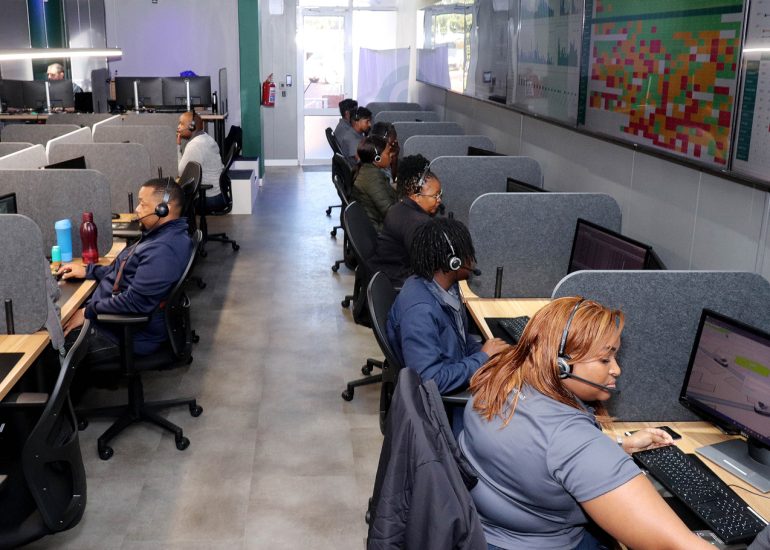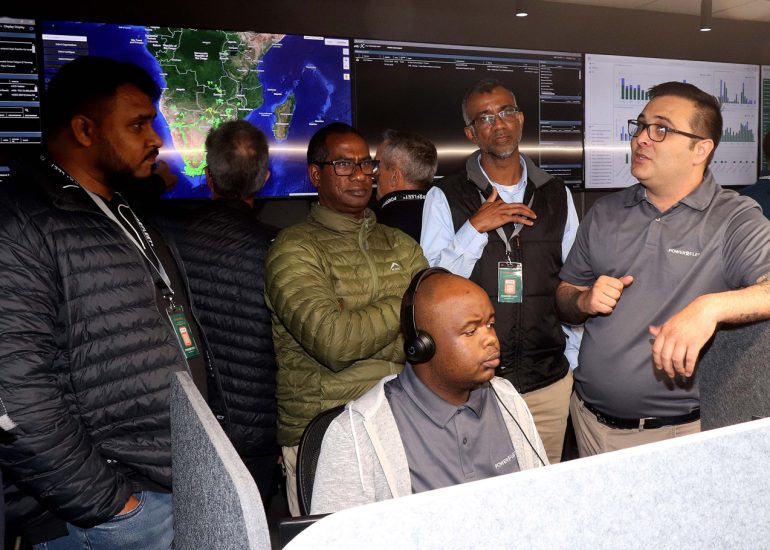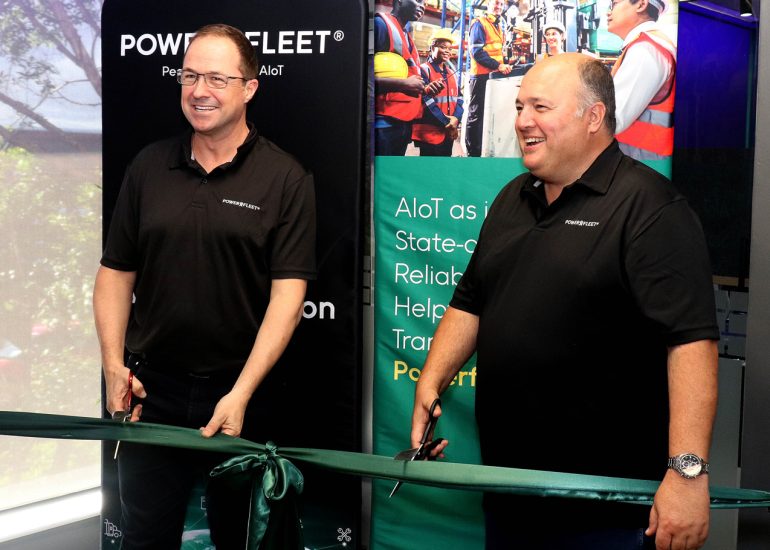Powerfleet’s Unity Operations Centre boosts efficiency
Powerfleet’s Unity Operations Centre boosts efficiency
Recognised as the third-largest artificial intelligence internet of things (AIoT) company globally, the US-headquartered Powerfleet officially launched its Unity Operations Centre in La Lucia, KwaZulu-Natal, in October 2024. NICOLA JENVEY attended the official opening.
Powerfleet’s multi-million rand investment into its Unity Operations Centre in South Africa will create around 400 jobs as it maximises modern technology to provide customers with real-time fleet management and safety. The initiative integrates advanced AI and IoT technologies into a unified operational hub that will operate four shifts of 50 operators, complemented by a second facility scheduled for Gauteng.
The centre follows a decade of fleet management innovation combining the proven success of the legacy MiX Telematics Track and React (TAR) and MiX Vision Bureau Services with AI-driven tools. Launched in 2010, TAR offered clients real-time driver monitoring and interventions, whereby agents contacted drivers in their native language for better understanding and compliance. Powerfleet Africa MD Brendan Horan says the product has evolved into a robust service catering to any fleet size, while subsequent innovation has introduced video footage to bolster road safety compliance and driver behaviour.
“The hub revolutionises fleet operations by applying real-time monitoring, proactive safety measures, and advanced risk management solutions to ensure customers remain at the forefront of their industries. Unity – our Software-as-a-Service (SaaS)-based, hardware agnostic platform – embodies our fleet management vision by collating cutting-edge technology and innovation to promote business intelligence,” explains Horan.
“The outcome is Vision AI Co-Pilot, a solution that leverages real-time AI analysis to predict and prevent accidents. The technology simultaneously analyses 587 data points to generate a single source of information capable of foreseeing impending risks,” he says, adding that the system also creates tangible reliability, as agents know how long it takes clients to respond when informed about a driver’s behaviour.
Powerfleet global product manager Rick Harrison says Unity and the Vision AI solutions solve the clients’ question, “Why did something happen?” Rather than analysing an accident, the extensive data collection can aggregate and mitigate the potential for a collision. The ability to interpret a driver’s mood – whether happy, sad, or distressed – through motion activation is a breakthrough in safety. “This technology allows for the detection of stress or signs of distress in real-time, which could indicate dangerous situations such as fatigue, distraction, or even potential hijackings. By identifying these cues early, the system can prompt timely interventions, ultimately reducing accidents and ensuring driver well-being,” Harrison elaborates.
While describing data as “the world’s new oil”, Powerfleet executive Steve Sutherland emphasises that without the ability to withdraw and analyse data, the information is “simply a data swamp”. AI has solved this issue by collating data from potentially countless sources and applying the outcome to appropriate responses.
“AI will not take away people’s jobs,” Sutherland stresses. “The Unity Operations Centre has enabled skilled agents with AIoT, teaching a new generation to apply AI in the workplace to benefit clients.” He says it is the closest experience Powerfleet has to “touching your business by being your co-pilots”.
“The AI-powered approach means fleets are not only monitored, but actively managed to reduce risks, enhance safety, and protect assets – saving lives, time, and money,” he continues.
In addition to enhancing fleet safety through AI-powered risk management, Powerfleet addresses a major operational challenge that costs companies millions: fuel theft and siphoning. This is tackled through a strategic partnership with TankSafe South Africa; MD Kenneth Bailey says fuel theft remains a critical issue, with drivers blatantly discussing their pilfering on social media. A total of 50 drivers siphoning 25 litres of diesel three times a week translates into R4.1 million annually.
“The drivers argue that in helping themselves to some of the diesel, they are compensating for the inequities experienced between them and office workers who enjoy the benefits associated with being office-bound,” relates Bailey, pointing out that it is impossible for companies to replace every driver caught siphoning fuel for illegal resale.
While innovation plays a critical role in tackling fuel theft, it is equally important to address the underlying employee dissatisfaction that leads to such behaviour. By combining advanced technological solutions with strong employee engagement initiatives, companies can reduce theft while fostering a culture of fairness and trust. This dual approach improves operational efficiency without sacrificing employee morale. Bailey adds that stopping diesel theft demands more levels of protection – or in other words, innovation. Third party theft accounts for 1% of fuel loss; the balance is made up by fuel skimming from company employees.
TankSafe has patented two cost-effective anti-siphon solutions. The first is for medium and heavy trucks with tank sizes below 400 litres, including plant equipment and refrigerated trailers. The second is a float-valve system for heavy and extra-heavy trucks filling more than 4,000 litres monthly, and with tanks exceeding 200 litres.
Bailey says the TankSafe Optimum anti-theft solution allows fuel to flow into the tank before locking it. The pressure of flowing fuel forces a floating ball down the cylinder during the filling process that then rises to lock the tank and prevent siphoning, overfilling, and spills. “This alleviates health and safety as well as environmental concerns,” he adds. The smaller TankSafe Shield solution, meanwhile, restricts the amount of fuel that can be skimmed from inside the anti-siphon chamber by limiting the volume exposed.
The company’s designs have been introduced as original equipment by various global truck manufacturers including Ford, Hino, Isuzu, Iveco, DAF, MAN, Mercedes-Benz, Tata, Volvo, and Powerstar. Looking ahead, Horan says the group already has a presence in Southern Africa. Through the international group, Powerfleet aims to become the global AIoT SaaS leader via its international partnerships.
Powerfleet’s US$405 million (R7.2 billion) global revenue is a testament to the company’s robust international presence, with over 40,000 customers across 120 countries. In South Africa, this impact is further magnified as Powerfleet deepens its market penetration, contributing significantly to the local economy and helping fleet operators overcome their most pressing challenges. The Unity Operations Centre is set to be a crucial hub, not only for South Africa but also for supporting Powerfleet’s growth throughout the Southern African region and beyond.
“With the Unity Operations Centre launch, Powerfleet is set to reshape the fleet management landscape in South Africa, providing unmatched safety, efficiency, and cost-saving solutions for local businesses,” says Horan. He also confirms that the centre serves a Mozambican client in Portuguese and is gearing up to service Francophone Africa. “As Powerfleet expands its reach to neighbouring regions and beyond, this initiative stands as a critical driver to improve fleet operations and road safety, not only nationally but on a global scale,” he concludes.
Published by
Focus on Transport
focusmagsa








